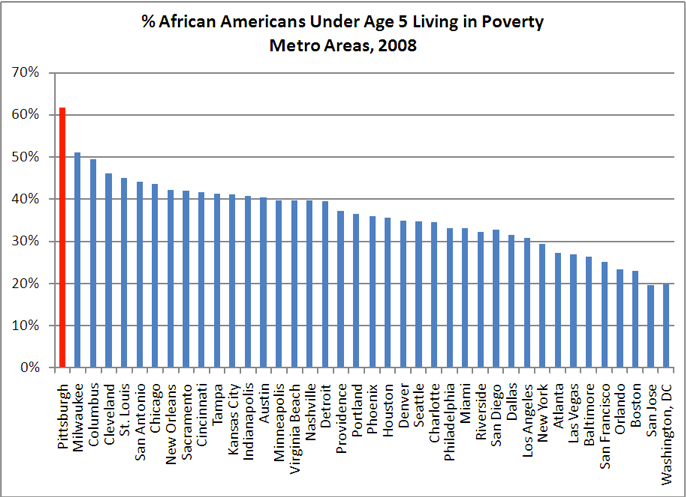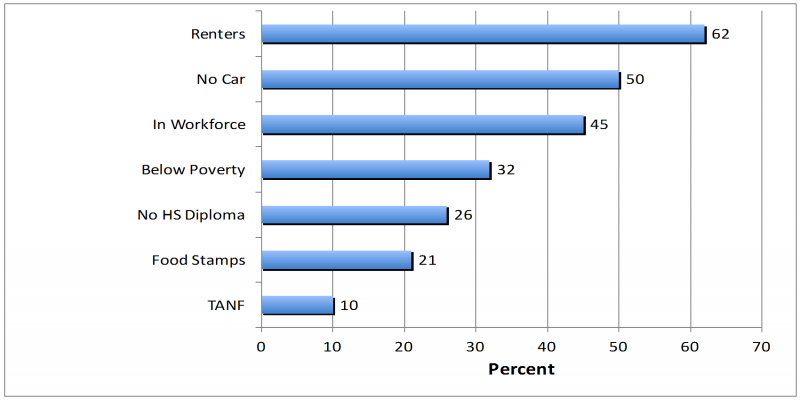While Pittsburgh has been given recent accolades for being one of the “most livable” cities in the nation, this is not the case for all of its citizens. Our partner on this project, Dr. John Wallace (Pitt’s School of Social Work) has graciously provided us with the following invaluable information that demonstrates why the DC HEaRT project has invested in Homewood and why the opportunity for growth in this community is limitless.
In 2015, a report from the Center on Race & Social Problems titled “Pittsburgh’s Racial Demographics 2015: Differences and Disparities” identifies some alarming statistics.
As can be seen in the following graphics, African Americans’ income is less than 50% of Whites, the unemployment rate is 2.5 times that of Whites, and African Americans in Pittsburgh are significantly less likely to own their homes:



In addition to these staggering statistics, in a 2008 study, Pittsburgh was shown to have the highest rate of poverty (over 60%) for African Americans under the age of 5 living in poverty in comparison to 40 of the largest cities in the country:

When looking specifically at Homewood, while the neighborhood is only 1 square mile, it has 6,602 residents, 96% of whom are African American. Of the total residents, 2,129 make up children and youth between the ages of 0-21 years. The chart below highlights the conditions of the families living in Homewood:

In our conversations with Dr. Wallace, we agreed that one of the significant ways that we can work to improve the living conditions of the families in Homewood was to address the problem of food access and insecurity. When surveyed, residents admitted the following:
30% (often or sometimes) - “We couldn’t afford to eat balanced meals”
40% (often or sometimes) - “The food that we bought just didn’t last, and we didn’t have money to get more”
48% (often or sometimes) - “We worried whether our food would run out before we got money to buy more.”
In order to tackle this problem, we worked with Dr. Wallace to find a way that direct current (DC) technology could be applied alongside additional green energy technologies to provide this community with a unique structure that could grow healthy and accessible food all-year round.
In addition, the use of DC technology can also be applied to address another issue with Homewood residents, the high cost of utilities. By using DC as the source of power in the Off-Grid DC Laboratory, we are able to monitor and research how effective DC power can be in the structure and how these savings can make a powerful case for the second phase of our project in Homewood, retrofitting the adjacent triplex building with AC/DC power. Our hope is to demonstrate that DC power can help lower the cost of utilities in the triplex and in turn, prove that the investment in DC power can ultimately help families in need.
In Homewood, we worked alongside Dr. John Wallace (Pitt's School of Social Work) and Dr. Stephanie Boddie (Baylor University, University of Pittsburgh, Carnegie Mellon University), to determine the best plan to (1) build an Off-Grid DC Laboratory on the land adjacent to a triplex home and, (2) converting the triplex structure to AC/DC power. Through the Business of Humanity® course (The Business of Humanity®: Strategic Management in the Era of Globalization, Innovation and Shared Value), the students’ work has been focused on projects in both Homewood and Gujarat, India. READ MORE
To discover more about our primary project partners on this project, please check out the following links to the Bible Center Church and Oasis Farm & Fishery websites.
Phase I Details
Phase I of our project in Homewood was completed in 2016. Since that time, the technology has improved and the cost of the equipment has become more affordable. To learn more about the equipment that was installed and how it operates within the Off-Grid DC Laboratory that was constructed during Phase I, please refer to this PDF manual.
We are also pleased to share additional details about the Off-Grid DC Laboratory including the project specs and site drawings. It is our hope that these materials can be used as a resource for others who are looking to replicate this type of system for either personal or commercial use.
Starting in 2018, the Oasis Farm & Fishery began hosting tours of the Off-Grid DC Laboratory. There have been many visitors since that time, including staff from Phipps Conservatory, the Society of Environmental Journalists, the Heinz Youth Philanthropy Scholars, Leadership Pittsburgh, the Sierra Club, and the Chamber of Commerce of Bucaramanga, Columbia.
June 2025
Phase II Details
The second phase of the project has been completed and is officially up and running! The goal of this phase of the project is to demonstrate how employing DC power can help lower the cost of utilities in the triplex. We are happy to share the details about the AC/DC retro-fit of the triplex including the project specs, site drawings, materials list, and vendor list. Like with the first phase of our project in Homewood, we are hoping these materials will be used as a reference for others to replicate this type of project for their own purposes.
April 2023
We’re excited to announce that work has begun on the second phase of our project in Homewood, PA! Check out the photos of a new solar pavilion that is being built on the site.
August 2022
Check out this article that was published on 8-24-22 in the Pittsburgh Post-Gazette which features our project partners in Homewood, Oasis Farm & Fishery. The article highlights their wonderful community and education programs as well as how crops in the bioshelter and adjacent vegetable garden continue to grow!
May 2019
In May 2019, we checked in with our partners at the Oasis Farm & Fishery to receive an update on the student and community programs they have been hosting at the site of the off-grid DC-Powered Laboratory. We were also curious about the groups who have visited the site from not just Pittsburgh, but from across the globe! Click here to view some exciting statistics and to see additional updates that we are happy to share!
Please check out this video, which follows-up on how the residents of Homewood, PA have been using the Off-Grid DC-Powered Laboratory. This includes an interview with Casey Clauser (Former Farm Manager, Oasis Farm & Fishery) who discusses the "Better Food, Better Me" program offered to local students as well as how the food grown at the site is used at the Everyday Café just blocks away in Homewood.
Please check out this exclusive video that shows the bio-shelter being built from the ground up!
